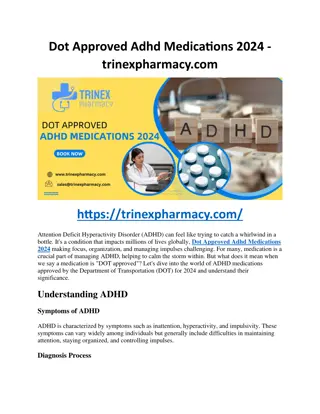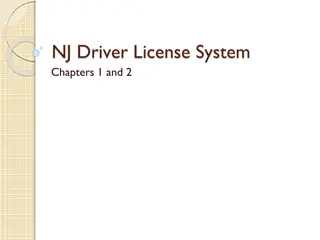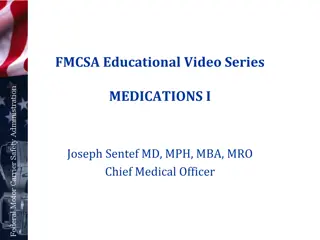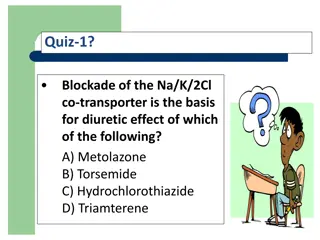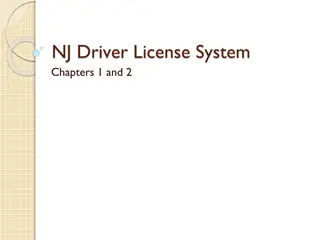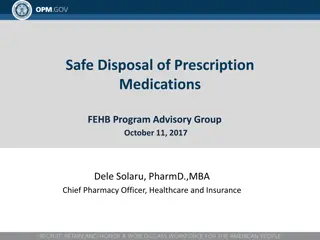Understanding Medications and Their Effects in DOT Driver Exams
This educational video series, presented by Dr. Joseph Sentef, Chief Medical Officer, covers medications commonly encountered during DOT driver exams. It addresses a range of medications like antipsychotics, antidepressives, and bipolar drugs, discussing their side effects, interactions, and appropriate usage. The content aims to help medical examiners, drivers, and safety departments understand how different medications can impact health and safety in a professional driving context.
Download Presentation

Please find below an Image/Link to download the presentation.
The content on the website is provided AS IS for your information and personal use only. It may not be sold, licensed, or shared on other websites without obtaining consent from the author. Download presentation by click this link. If you encounter any issues during the download, it is possible that the publisher has removed the file from their server.
E N D
Presentation Transcript
FMCSA Educational Video Series MEDICATIONS II Joseph Sentef MD, MPH, MBA, MRO Chief Medical Officer
MEDICATIONS II This educational presentation will cover medications with possible side effects and drug interactions often encountered by medical examiners while performing DOT driver exams. This video is intended to provide information to help apply standards in the Federal regulations or serve as a reference for medical examiners, drivers, and motor carrier safety departments. This video and its contents are strictly educational and not legally binding on medical examiners. The most current safety, diagnostic and treatment information was obtained from various evidence-based, patient-specific guidelines. 2
MEDICATIONS II The video addresses the following medications: Antipsychotics 1. First-Generation 2. Second-Generation Antidepressives 1. Tricyclics 2. SSRIs 3. SNRIs 4. NDRIs Bipolar 1. Anticonvulsants 2. Lithium 3
Antipsychotic Medications First-generation antipsychotics (FGA) are known as but not limited to: haloperidol, fluphenazine, perphenazine, and chlorpromazine. FGAs reduce dopaminergic neurotransmission in the four dopamine pathways by blocking dopamine D2 receptors. The dopamine D2 receptor is the main receptor for all antipsychotic drugs. First-generation antipsychotics (FGA) are used to treat psychotic disorders like schizophrenia, to help control motor movement and verbal tics (Tourette Syndrome), to treat mania in bipolar disorders, for nausea and vomiting, agitation and delirium, acute psychosis, and hallucinations in alcohol withdrawal. First-generation antipsychotics (FGA) should be avoided in individuals with cardiac issues, Parkinson s disease, prostate issues, hyperthyroidism, glaucoma and seizures. 4
FGA Antipsychotics Dosage: haloperidol: 0.5mg, 1mg, 2mg, 5mg, 10mg, 20mg Half-life* 21-24 hours (long-acting) fluphenazine: 1mg, 2.5mg, 5mg, 10mg Half-life* 14.7-15.3 hours (long-acting) perphenazine: 2mg, 4mg, 8mg, 16mg, 2 to 4 times daily Half-life* 9-12 hours (medium-acting) chlorpromazine: 10mg, 25mg, 50mg,100mg, 200mg Half-life* 23-37 hours (long-acting) The half-life is the amount of time it takes for half of the drug to be eliminated from the body. The shorter the half-life, the quicker the drug is eliminated. 5
First-Generation Antipsychotics Side Effects: Common side effects include but are not limited to the following: blurred vision, akathisia, constipation, weight gain, xerostomia, loss of balance control, difficulty with speaking or swallowing, inability to move eyes, muscle spasms, shaking of hands or fingers, and weakness of arms or legs Drug Interactions: Alcohol can increase the nervous system side effects such as dizziness, drowsiness, and difficulty concentrating Interaction with opioids such as tramadol or oxycodone can depress the central nervous system causing extreme sleepiness, slowed or difficult breathing, coma, or death Interaction with the antidepressant bupropion will lower the seizure threshold 6
Second-Generation Antipsychotics Second-generation antipsychotics (SGA) are known as but not limited to: risperidone, quetiapine, ziprasidone, aripiprazole, lurasidone, clozapine, olanzapine, paliperiodone These second-generation antipsychotic medications are used to treat bipolar disorders, Tic disorders/Tourette Syndrome, schizophrenia and are used as an adjunct in major depressive disorder. Second- generation antipsychotics generally have lower risk of extrapyramidal side effects and dyskinesia compared with first- generation antipsychotics The exact mechanism of action is unknown but they antagonize dopamine D2 receptors and serotonin 5-HT2A receptors among others. 7
Second-Generation Antipsychotics Dosage: risperidone: 0.25mg to 4mg ..Half-life* 20 hrs (long-acting) quetiapine: 25mg to 400mg Half-life* 6-7 hrs (short-acting) ziprasidone: 20mg to 80mg Half-life* 7 hrs (short-acting) aripiprazole: 2mg to 30mg ..Half-life* 75 hrs (long-acting) lurasidone: 20mg to 160mg Half-life* 18 hrs (long-acting) clozapine: 12.5mg to 200mg ...Half-life* 4-66 hrs (long-acting) olanzapine: 2.5mg to 20mg ..Half-life* 21-54 hrs (long-acting) paliperiodone: 1.5mg to 9mg ..Half-life* 23 hrs (long-acting) The half-life is the amount of time it takes for half of the drug to be eliminated from the body. The shorter the half-life, the quicker the drug is eliminated. 8
SGA Antipsychotics Side effects: SGA antipsychotic common side effects include extrapyramidal symptoms, tachycardia, somnolence, anxiety, headaches, dizziness, akathisia, dizziness, dysarthria, xerostomia, asthenia, hyperglycemia and parkinsonism Drug interactions: Individuals on SGA antipsychotics such avoid taking medications that could cause hypotensive effects, lower the seizure threshold, or cause hyperglycemia SGA psychotics taken with opioids can cause central nervous system depression leading to respiratory distress SGA antipsychotics can interact with SSRI antidepressants to cause irregular heart rhythms SGA antipsychotics can interact with benzodiazepines to cause excessive sedation, dizziness, confusion or lack of coordination. 9
Antidepressants: Tricyclics Tricyclic and tetracyclic antidepressants are known as but not limited to: amitripyline, amoxipine, clomipramine, desipramine, doxepin, nortriptyline, mirtazapine, and imipramine Tricyclic antidepressants are used to treat mental and mood problems such as depression. These antidepressants work by affecting the balance of certain natural chemicals (neurotransmitters such as serotonin) in the brain to maintain mental balance. These medicines are also used to treat eating disorders, migraine headaches, post-herpetic neuralgia, neuropathy, fibromyalgia, and less commonly, insomnia. 10
Antidepressant: Tricyclics Side Effects: Common side effects include but are not limited to as follows: drowsiness, dizziness, blurred vision, palpitations, tachycardia, impaired coordination, diaphoresis, weakness, disorientation, confusion, restlessness, insomnia, anxiety/agitation, tremor, paresthesia, hypo/hyperglycemia, photo sensitivity, rash, pruritus, constipation, nausea/vomiting, and impotence Serious side effects include but are not limited to as follows: syncope, hypotension, ventricular arrhythmias, myocardial infarction, seizures, ataxia, stroke, AV heart block, hallucinations, heat stroke, psychosis, hepatitis, depression exacerbation, suicidality, hematological disorders, glaucoma, prolonged QT, and withdrawal symptoms 11
Tricyclics: Drug Interactions Drug Interactions: Tricyclic antidepressants in combination with caffeine, ibuprofen or phenylephrine may increase the risk of hypertension Amitriptyline with dextromethorphan may increase risk of serotonin syndrome Amitriptyline with chlorpheniramine may increase risk of CNS depression, psychomotor impairment, and anticholinergic effects Tricyclic antidepressant use with amphetamines may increase risk of hypertension, tachycardia and serotonin syndrome Tricyclic antidepressant use with amlodipine, valsartan or hydrochlorothiazide may increase risk for hyponatremia (low sodium) and alter blood pressure control Tricyclic antidepressants taken with topiramate will increase risk for CNS depression, psychomotor impairment, and may increase seizures by decreasing the seizure threshold 12
Antidepressants: Tricyclics Dosage: amitriptyline: 10mg to150mg ..Half-life* 10-26 hours amoxipine: 25mg to 150mg .. Half-life* 8 hours clomipramine: 25mg to 75mg . Half-life* 32 hours desipramine: 10mg to 150mg . .Half-life* 12-27 hours doxepin: 10mg to 150mg Half-life* 15.3 hours Nortriptyline: 10mg to 75mg .Half-life* 18-44 hours mirtazapine: 7.5mg to 45mg . Half-life* 20-40 hours imipramine: 75mg-150mg ..Half-life* 11-25 hours The half-life is the amount of time it takes for half of the drug to be eliminated from the body. The shorter the half-life, the quicker the drug is eliminated. 13
Antidepressants: SSRIs Known as but not limited to: celexa, citalopram, escitalopram, fluoxetine, paroxetine, sertraline SSRIs or selective serotonin reuptake inhibitors are used to treat depression and various other conditions such as anxiety, chronic pain, eating disorders, PTSD, panic disorder, obsessive-compulsive disorder along with social anxiety disorders. They have become first-line choices for major depression along with cognitive therapy. The exact mechanism of action is unknown. They are believed to increase the extracellular level of the neurotransmitter serotonin by limiting its reabsorption into the presynaptic cell, increasing the level of serotonin in the synaptic cleft available to bind to the postsynaptic receptor. Serotonin is a neurotransmitter often referred to as the feel good hormone. It helps regulate the body s sleep-wake cycle and internal clock. 14
Antidepressants: SSRIs Side Effects: Common side effects of SSRIs include but are not limited to: insomnia, headaches, nausea, anxiety, yawning, tremor, dizziness, abnormal dreams, visual disturbance, diaphoresis, constipation/diarrhea, rash, xerostomia, dyspepsia, flu syndrome and impotence. Severe side effects of SSRIs include but are not limited to: serotonin syndrome, suicidality, seizures, glaucoma, mania, hyponatremia, exacerbation of depression, platelet abnormalities, pulmonary fibrosis, serum sickness, hypoglycemia, vasculitis, extrapyramidal symptoms, withdrawal symptoms upon abrupt stoppage, QT prolongation, and Stevens-Johnson syndrome. 15
SSRIs: Drug Interactions Drug Interactions: SSRIs can interact with alcohol to potentially increase the nervous system side effects resulting in dizziness, drowsiness, difficulty concentrating, impairment in thinking and judgment SSRIs such as fluoxetine may increase the risk of bleeding when taken with aspirin or ibuprofen SSRIs interact with diphenhydramine and chlorpheniramine to increase the risk of CNS depression and psychomotor impairment SSRIs interact with dextromethorphan to increase the risk of serotonin syndrome SSRIs interact with amphetamines increases the risk of serotonin syndrome SSRIs when taken with hydrochlorothiazide or spironolactone may increase the risk for hyponatremia or SIADH SSRIs when taken with opiates may increase risk of CNS and respiratory depression along with psychomotor impairment 16
Antidepressants: SSRIs Dosage: celexa: 10mg, 20mg, 40mg Half-life*35 hours citalopram: 10mg, 20mg, 40mg Half-life*35 hours escitalopram: 5mg,10mg, 20mg Half-life*27-32 hours fluoxetine: 10mg, 20mg, 40mg Half-life*4-6 days paroxetine: 10mg, 20mg, 30mg, 40mg Half-life*21 hours sertraline: 25mg, 50mg, 100mg Half-life*26 hours The half-life is the amount of time it takes for half of the drug to be eliminated from the body. The shorter the half-life, the quicker the drug is eliminated. 17
Antidepressants: SNRIs Known as but not limited to: duloxetine, venlafaxine, desvenlafaxine, milnacipran, levomilnacipran SNRIs or serotonin norepinephrine reuptake inhibitors are a class of medications that are effective in treating depression but are used to treat other conditions such as fibromyalgia, anxiety disorders, chronic pain, obsessive-compulsive disorder, hot flashes and neuropathy. SNRIs block the reabsorption or reuptake of the neurotransmitters serotonin and norepinephrine in the brain. Serotonin seems to help regulate mood. Norepinephrine regulates mood and seems to be involved in pain perception, motivation, and concentration. Pain and depression are closely related, so SNRIs are being used to treat both pain and depression. 18
Antidepressants: SNRIs Side effects: Common side effects of SNRIs include but are not limited to: headaches, nausea, insomnia, dizziness, anorexia, somnolence, xerostomia, asthenia (weakness), diaphoresis, hypertension, nervousness, abnormal dreams, blurred vision, anxiety, tremor, agitation, abdominal pain, yawning, and palpitations/tachycardia Severe side effects of SNRIs include but are not limited to: hypomania/mania, serotonin syndrome, seizures, hypertension, pancreatitis, liver toxicity, arrhythmias, interstitial lung disease, blood dyscrasias, hyponatremia, withdrawal symptoms if stopped abruptly, glaucoma, suicidality, depression exacerbation, SIADH, Stevens-Johnson syndrome, and erythema multiforme 19
Antidepressants: SNRIs Drug Interactions: SNRIs and antipsychotics such as aripiprazole may increase risk of CNS depression, psychomotor impairment, and serotonin syndrome (additive effects) SNRIs taken with aspirin may increase risk of bleeding SNRIs taken with diphenhydramine may increase risk of CNS depression and psychomotor impairment SNRIs taken with dextromethorphan may increase risk of serotonin syndrome SSRIs interact with amphetamines by increasing the risk of serotonin syndrome SSRIs when taken with hydrochlorothiazide or spironolactone may increase the risk for hyponatremia or SIADH SSRIs when taken with opiates may increase risk of CNS and respiratory depression along with psychomotor impairment 20
Antidepressants: SNRIs Dosage: Duloxetine: 20mg, 30mg, 40mg, 60mg Half-life* 12 hours Venlafaxine: 37.5mg, 75mg, 150mg Half-life* 5 hours Desvenlafaxine: 25mg, 50mg, 100mg Half-life* 11 hours Milnacipran: 12.5mg, 25mg, 50mg,100mg- Half-life* 6-8 hours Levomilnacipran: 20mg, 40mg, 80mg,120mg Half-life* 12 hours 21
Antidepressants: NDRIs Known as but not limited to: bupropion These antidepressants are norepinephrine and dopamine reuptake inhibitors that block the action of specific transporter proteins, increasing the amount of active norepinephrine and dopamine neurotransmitters throughout the brain. Norepinephrine is thought to play a role in the body s stress response and helps to regulate sleep, alertness, and blood pressure. Dopamine plays a key role in movement and affects motivation, perception of reality, and the ability to experience pleasure. NDRIs are used to treat major depression disorder, particularly in individuals who do not respond well to SSRIs. They also treat seasonal affective disorder, smoking cessation, bipolar depression, ADHD, and SSRI-associated sexual dysfunction. 22
Antidepressants: NDRIs Side Effects: Common side effects of NDRIs include but are not limited to as follows: headaches, agitation, xerostomia, dizziness, nausea, tremor, diaphoresis, abnormal dreams, insomnia, tinnitus, rash, diaphoresis, pharyngitis, tachycardia, anxiety, blurred vision, chest pain, arthralgias/myalgia, urinary frequency, and abdominal pain Severe side effects of NDRIs include but are not limited to as follows: seizures, mania, severe hypertension, myocardial infarction, arrhythmias, glaucoma, anaphylaxis, homicidal and suicidal ideation, liver toxicity, erythema multiforme, and neuropsychiatric disorders Drug Interactions: Bupropion and caffeine may increase the risk of hypertension Bupropion taken with opiates may increase opiate levels and increases risk of CNS and respiratory depression, increases risk of seizures, increases depression, and psychomotor impairment 23
Antidepressants: NDRIs Drug Interactions: continued Bupropion taken with pseudoephedrine, phenylephrine, and ibuprofen/naproxen may increase risk of hypertension Bupropion taken with amphetamines may increase risk of serotonin syndrome, seizures, and hypertension Bupropion taken with amlodipine or hydrochlorothiazide may decrease antihypertensive effect Bupropion taken with amitriptyline increases risk of QT prolongation, cardiac arrhythmias, hypertension, and seizures Bupropion taken with topiramate or phentermine may increase risk of seizures Dosage: Bupropion: 75mg,100mg Half-life* 21 hours The half-life is the amount of time it takes for half of the drug to be eliminated from the body. The shorter the half-life, the quicker the drug is eliminated. 24
Bipolar Disorder Medications Known as but not limited to: lamotrigine, carbamazepine, lithium, valprioc acid, tiagabine, and divalproex These medications have multiple uses but all of them have been used in treating bipolar disorder and are fairly commonly seen during DOT physicals. Bipolar disorder is characterized by periods of excitability (mania) alternating with periods of depression. The mood swings between mania and depression are often very abrupt. Individuals with bipolar disorder experience periods of unusually intense emotion, changes in sleep patterns and activity levels, and unusual behavior. Many individuals have bipolar disorder in conjunction with other illness such as anxiety, substance abuse, or an eating disorder. These individuals are also at higher risk for thyroid disease, migraine headaches, heart disease, diabetes, obesity and other physical illnesses. Bipolar disorder is a lifelong illness and mood stabilizers, atypical antipsychotics, and antidepressants are used for treatment. 25
Bipolar Disorder Medications lamotrigine: This drug is an anticonvulsant medication used for both bipolar disorder and seizures. It blocks the sodium channel leading to stabilization of neural membranes. Common side effects include but are not limited to as follows: dizziness, ataxia, vertigo, diplopia, blurred vision, tremor, insomnia, back pain, fever, headaches, and somnolence. Serious side effects include but are not limited to as follows: seizures, liver failure, depression exacerbation, and blood dyscrasias. Drug Interactions: Black box warning note serious rashes including Stevens-Johnson syndrome Lamotrigine taken with amphetamines, phentermine, or bupropion may alter seizure control Lamotrigine taken with amphetamines may increase risk of CNS depression, psychomotor impairment, and may alter seizure control Lamotrigine taken with benzodiazepines, opiates, and topiramate may increase risk of CNS, respiratory depression, and psychomotor impairment 26
Bipolar Medications carbamazepine: This drug is an anticonvulsant medication used for epilepsy, neuropathic pain, and bipolar disorder. It is a sodium channel blocker which prevents repetitive and sustained firing of an action potential. Common side effects include but are not limited to as follows: dizziness, ataxia, drowsiness, blurred vision, speech disturbances, hypertension, tremor, muscle twitching, hyponatremia, and unsteadiness. Serious side effects include but are not limited to as follows: syncope, AV heart block, arrhythmias, pancreatitis, hematologic disorders, and hyponatremia. Drug Interactions: Black box warning includes an 8x greater risk fro aplastic anemia Carbamazepine taken with acetaminophen increases risk of acetaminophen toxicity Carbamazepine taken with first-generation antihistamines and opiates increases risk for CNS depression, and psychomotor impairment Caffeine or Clarithromycin taken with carbamazepine may increase carbamazepine levels Amoxicillin taken with carbamazepine may decrease the seizure threshold 27
Bipolar Medications This drug is used for the treatment of bipolar and depressive disorders. Lithium is a positively charged element that interferes with production and uptake of neurotransmitters both inside and outside of cells. It also affects the concentrations of tryptophan and serotonin in the brain. Common side effects include but are not limited to as follows: drowsiness, cognitive impairment, impaired coordination, dizziness, muscle weakness, fatigue, hyponatremia, and lithium toxicity related to serum lithium levels. Serious reactions include but are not limited to: seizures, syncope, bradycardia, serotonin syndrome, hypercalcemia, ventricular arrhythmias, and coma. Drug Interactions: Lithium taken with diuretics (HCTZ, spironolactone) and valsartan (ARBs) may increase nephrotoxicity, CNS depression, and psychomotor impairment Lithium taken with antacids will decrease lithium levels and efficacy Lithium taken with tetracycline or metronidazole will increase toxicity risk Lithium taken with SSRIs, SNRIs, or amitriptyline increases risk for serotonin syndrome lithium: 28
Bipolar Medications Tiagabine is an anticonvulsant used to treat seizures, panic disorder and bipolar disorder. It increases the level of GABA by blocking the GABA transporter 1 and is classified as a GABA reuptake inhibitor. Common side effects include but are not limited to: dizziness, somnolence, tremor, impaired concentration and memory, emotional lability, depression, hostility, nystagmus, speech disturbance, confusion, insomnia and cough. Severe side effects include but are not limited to as follows: CNS depression, seizures, withdrawal symptoms, severe rash, and incapacitating weakness. Drug Interactions Tiagabine taken with amphetamines may alter seizure control Tiagabine taken with opiates may increase risk of CNS and respiratory depression, psychomotor impairment and decrease the seizure threshold Tiagabine taken with SSRIs, SNRIs, amitriptyline, and antipsychotics may increase the risk of CNS depression, psychomotor impairment and decrease the seizure threshold Tiagabine taken with bupropion may alter seizure control 29 tiagabine:
Bipolar Medications Valproic acid is used to treat epilepsy, bipolar disorder, and to prevent migraine headaches. It also treats schizophrenia. The anticonvulsant effect has been attributed to the blockade of voltage-gated sodium channels and increased brain levels of GABA. Common side effects include but are not limited to as follows: headaches, tremor, dizziness, somnolence, depression, dyspnea, tinnitus, amnesia, blurred vision, abnormal gait, nystagmus, and peripheral edema Serious side effects include but are not limited to as follows: parkinsonism, bleeding, hypothermia, aplastic anemia, hallucinations, SIADH, and psychosis Drug Interactions Valproic acid taken with aspirin or ibuprofen increases the risk for bleeding Valproic acid taken with amphetamines decreases the seizure threshold Valproic acid taken with opiates or barbiturates may increase CNS and respiratory depression, affect the liver, and cause psychomotor impairment Valproic acid taken with SSRIs, SNRIs, and antipsychotics may increase the risk for SIADH, CNS depression, psychomotor impairment and seizures valproic acid/divalproex: 30
Bipolar Disorder Medications Dosage: lamotrigine: 25mg, 100mg, 150mg, 200mg Half-life* 25 hours carbamazepine:100mg, 200mg, 300mg Half-life* 25-65 hours lithium:150mg, 300mg, 600mg Half-life* 18-36 hours valproic acid: 250mg Half-life* 16 hours tiagabine: 2mg, 4mg, 12mg, 16mg Half-life* 7-9 hours divalproex: 125mg, 250mg, 500mg Half-life* 9-16 hours The half-life is the amount of time it takes for half of the drug to be eliminated from the body. The shorter the half-life, the quicker the drug is eliminated. 31


![[PDF⚡READ❤ONLINE] Planet Mercury: From Pale Pink Dot to Dynamic World (Springer](/thumb/21549/pdf-read-online-planet-mercury-from-pale-pink-dot-to-dynamic-world-springer.jpg)


